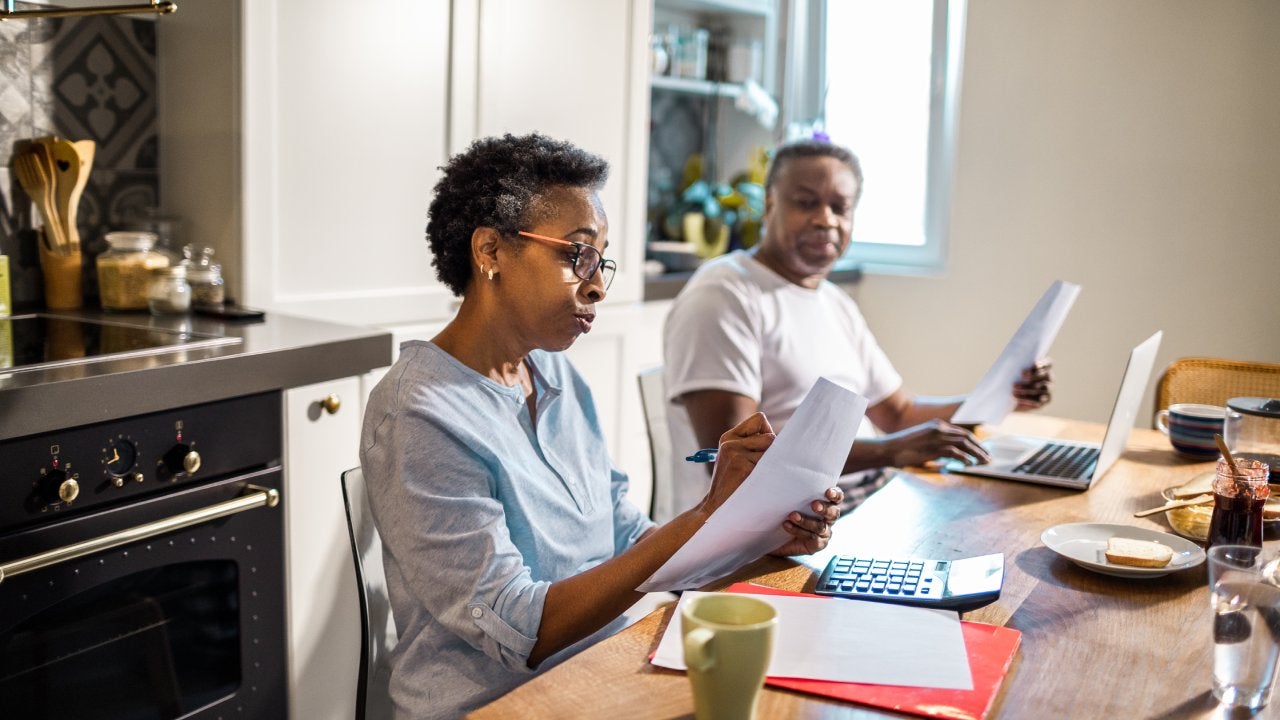How to split home equity in a divorce




Key takeaways
- The division of home equity during divorce typically depends on various factors, including any pre- or postnuptial agreements, state laws and the couple’s specific circumstances.
- In community property states, the home and its equity are typically split 50/50 between spouses; in equitable distribution states, property acquired during the marriage is divided based on what is considered fair.
- Options for splitting equity include selling the home and dividing the proceeds, one spouse buying out the other, and co-ownership or deferred sale agreements.
Divorce isn’t just about emotional separation: It’s about financial separation, too, especially when it involves shared property like a home, the most valuable asset many people own. When a couple decides to part ways, one of the most challenging aspects of splitting up is figuring out what happens to the home — and each party’s ownership stake, or equity, in it.
If you own the home outright, splitting the home equity can be relatively straightforward. However, things can get more complicated if the property has a mortgage or another lien on it, like a home equity loan.
It’s a lot to sort through, but understanding the options, having a clear plan, and being open to compromise can make the whole process smoother.
$302,000
Source: Cotality
How home equity is divided in divorce
The division of home equity during divorce typically depends on various factors, including any prenuptial or postnuptial agreements, if the home was bought after marriage, and state laws – specifically, whether the divorcing couple resides in a community property state or an equitable distribution state.
Community property and equitable distribution states
Community property states are states where marital property is typically divided equally (50/50) between spouses upon divorce, while equitable distribution states divide marital property based on what is considered “fair” – which may not amount to a numerically equal split. The vast majority of states are equitable property states.
If a couple buys a house together after marriage, it is considered marital property. If one spouse bought and owned the house before marriage, it’s usually considered separate property, and so that person generally gets to keep it.
However, things can get a little more complicated if the non-owner spouse helps pay the mortgage, repairs, renovations or other expenses related to the home. In this instance, the house may be considered a commingled asset: While one spouse has ownership, the other spouse has a claim to some equity because of their financial contributions. Courts have also been known to take into account “sweat equity,” non-financial contributions a non-owning spouse may have put into a home (running, maintaining or working on it), especially if those efforts have helped the home appreciate in value.
All this means that “it’s not automatic that the house goes to [the owner],” says Renee Coleman, a Wilmington, Mass.-based certified divorce lending professional (CDLP) and loan originator with CrossCountry Mortgage. Even if it does, the other spouse has a stake, and merits compensation for it — based on value changes during the marriage. Say “I bought the house for $200,000, but when you moved in, it was $300,000 and today it’s worth $500,000. [The courts] are only going to look at the increase in equity from the time you were married and in the home,” she explains.
How to split home equity in a divorce: 3 options
Most options for dividing equity in divorce involve first assessing the property’s value. This step is crucial because it determines home equity, the difference between the property’s market value and the remaining mortgage amount.
Whatever valuation measure you choose, experts say both parties must agree on the method, and to accept the results of it.
-
- A comparative market analysis (CMA) estimates the value of a home based on recent sales of similar properties in the area.
-
- A broker price opinion (BPO) is an estimate of the property’s value prepared by a qualified real estate agent or a real estate broker. Often used to set a listing price, it assesses the home’s conditions and can include a CMA.
-
- A home appraisal is an uninvolved, third-party determination of how much the property is worth. It’s done by a professional appraiser, according to certain criteria.
-
- Online valuation tools can also estimate your home’s worth. They’re not as accurate as a professional appraisal, though — more of a ballpark figure to get you started.
Once the home’s value — and each partner’s stake in that value — is determined, you can move forward with a plan. While the variations are many, options for divvying up home equity in a divorce fall into three basic categories.
1. Sell the house and split the equity
This option is best for couples who want a clean break financially and prefer to avoid The home is put up for sale, and, after paying off liabilities like a mortgage and a home equity loan or line of credit (if there is one), the remaining equity is typically split between the couple according to their divorce agreement.
Adam Coleman, a CDLP and branch manager at Loan Pronto, a mortgage broker based in Charlotte, NC, calls it “the path of least resistance: Sell the house, split the equity, and then both people go their separate ways.” It avoids having to remove a person from the title or mortgage or the complications of co-ownership.
However, with record home prices, high home loan rates, and rising rents, this option may be less desirable for divorcing couples nowadays. “To get a comparable home to what you’re leaving, it’s going to cost that much more,” says Renee. “Prices of homes are going up and the interest rates are a lot higher. It’s a very real challenge right now. Even if you decide we’re going to sell the house and [each of us] going to rent, likely you’re gonna pay more in rent than you were paying for your mortgage.”
It’s also important to consider the broader financial implications of selling a house. The equity is divided between the two parties after any existing debts and costs to sell the home, like closing costs, are paid. Additionally, the sale of the home may trigger tax consequences, such as capital gains or transfer taxes.

Pros
- Simplifies the equity division process
- Provides a clean financial break/fresh start
- Avoids disputes over who is responsible for what, or who deserves what

Cons
- Closing costs and debt settlements reduce the amount of equity each spouse receives
- High home prices and interest rates may make it challenging to buy a comparable home afterward
- Renting after the sale may cost more than previous mortgage payments
2. Buy out one spouse
Plan B: One spouse becomes sole owner of the home, compensating the other for their equity share in it — buying them out, basically. This option is best for divorcing couples when one person wants to keep the home, and has the means to compensate the other person.
If the home is owned free and clear and one party wants to keep the property, a quitclaim deed may be the only thing that’s required. The document releases a person’s interest in the property and removes their name from the title.
It gets trickier if the property still has a mortgage on it, though. The purchasing spouse generally can’t just take over the existing mortgage, if it’s in the other spouse’s name or even if the couple took it out together. Most loans are not assumable, meaning they can’t be transferred from one borrower to another (and those that can be assumed still require the lender’s approval). To do the buy-out option, a mortgage refinance would need to happen.
Refinancing is just like getting a brand-new mortgage; you’ve got to go through the whole application process again. It means qualifying for the loan with one income (though spousal or child support payments can be included), which may be challenging. Equally challenging: The remaining spouse has to come up with the funds to buy out the other spouse. If they can’t do it out of pocket, they can try to get extra funds while refinancing.
An equity buyout loan is a type of mortgage refinance used in divorce, in which one spouse refinances the existing mortgage in their name and pulls out enough equity to pay the other spouse their share of the home’s value. An equity buyout loan is essentially a divorced-focused use of a cash-out refinance, intended to satisfy the terms of a settlement. divide property between spouses. Unlike a standard cash-out refi, an equity buyout is specifically structured to divide property between the spouses — any cashback received goes to compensate the bought-out individual — and to remove one spouse from the mortgage and title of the home.
“If they don’t have enough equity in that home to clear the original mortgage plus pay off the ex-spouse what they’re wanting, then someone’s either bringing more money to the table or they default back to selling the house and just walk away with what they can,” says Stephanie.

Pros
- Allows one person to stay in the home
- Avoids the hassle and cost of selling the home
- Clean break in ownership

Cons
- Requires significant cash outlay for the buy-out
- Requires one person to qualify for refinance (if property is mortgaged)
3.Co-own the home/deferred sale
Going for a deferred sale, sharing ownership of the home in the meantime, can be another practical solution. This option works best for divorcing couples with children who want to maintain as much stability in their lives as possible.
This arrangement allows one spouse, typically the one with primary custody of the children, to stay in the home. “Maybe the kids have a couple of years left of high school and you don’t want to uproot them and move to a different area,” says Renee Coleman. “That’s the sort of the circumstance we see most often when both are going to maintain ownership of the house.”
In many cases, the title and mortgage remain unchanged during this period. However, in the face of rising mortgage rates, Adam Coleman says couples have gotten more creative with co-ownership agreements in the last few years.
“Let’s say the vacating spouse was on the mortgage,” he says. “They are willing to build into the settlement agreement that they’re going to remain on the mortgage for a year, two years or three years or however long it takes for the spouse staying in the house to refinance into just their name. This is done with the hopes that mortgage rates somehow drop ‘x’ amount of percentage points to get them comfortable with the refinance.”
This solution simplifies life, because it maintains the status quo. However, it’s crucial that a co-ownership agreement be a temporary arrangement, with a finite term, because it involves risks – especially for the vacating spouse. “The person that’s vacating the home, they’re still on the mortgage,” says Adam. “That mortgage payment is still tied to their credit report and their Social Security number. So if the person keeping the home misses a payment or goes into default – the vacating spouse’s credit would be drastically diminished at that point.”
To help prevent misunderstandings and disputes, experts recommend a legal agreement outlining each party’s rights and responsibilities regarding the property, including financial contributions and the process for selling or refinancing the home.

Pros
- Maintains stability for children
- Allows more time for refinancing or a more favorable market to sell
- Avoids immediate disruption to housing and finances

Cons
- The vacating spouse remains financially liable, risking their credit if payments are missed
- Couple must maintain ongoing legal entanglements/relationship
- Must be carefully structured with clear timelines to prevent conflict
Final word on home equity and divorce
Splitting equity in a divorce can be tough, both emotionally and financially. Whether you decide to sell the house, buy out the other party, or agree to own it together, each option comes with a mix of pros, cons and hard choices.
“It’s the coming together that is sometimes the hardest part,” says Fields. “In divorce situations, there’s generally adversity.”
Navigating the complexities of dividing home equity is best not to do alone. Divorce attorneys and real estate agents can walk you through your options. You might consult a certified divorce lending professional (CDLP), who is trained in the financial and legal aspects of divorce — particularly as it relates to real estate, mortgages and financing. While hiring a pro may seem like an additional, unnecessary expense, “when you have the right people who specialize in everything, it’s just more efficient,” Adam Coleman notes.
FAQ
Additional reporting by Larissa Runkle
Why we ask for feedback Your feedback helps us improve our content and services. It takes less than a minute to complete.
Your responses are anonymous and will only be used for improving our website.




